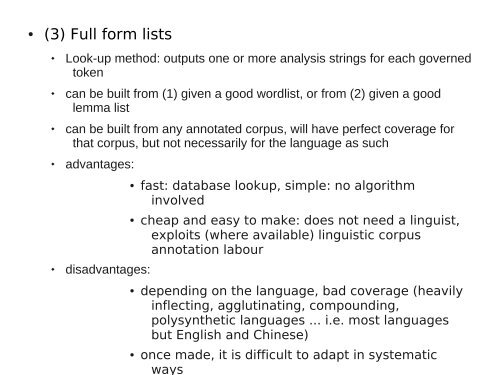On how to write rules in Constraint Grammar (CG-3) - VISL
On how to write rules in Constraint Grammar (CG-3) - VISL
On how to write rules in Constraint Grammar (CG-3) - VISL
You also want an ePaper? Increase the reach of your titles
YUMPU automatically turns print PDFs into web optimized ePapers that Google loves.
●<br />
(3) Full form lists<br />
<br />
<br />
<br />
<br />
<br />
Look-up method: outputs one or more analysis str<strong>in</strong>gs for each governed<br />
<strong>to</strong>ken<br />
can be built from (1) given a good wordlist, or from (2) given a good<br />
lemma list<br />
can be built from any annotated corpus, will have perfect coverage for<br />
that corpus, but not necessarily for the language as such<br />
advantages:<br />
●<br />
●<br />
disadvantages:<br />
●<br />
●<br />
fast: database lookup, simple: no algorithm<br />
<strong>in</strong>volved<br />
cheap and easy <strong>to</strong> make: does not need a l<strong>in</strong>guist,<br />
exploits (where available) l<strong>in</strong>guistic corpus<br />
annotation labour<br />
depend<strong>in</strong>g on the language, bad coverage (heavily<br />
<strong>in</strong>flect<strong>in</strong>g, agglut<strong>in</strong>at<strong>in</strong>g, compound<strong>in</strong>g,<br />
polysynthetic languages ... i.e. most languages<br />
but English and Ch<strong>in</strong>ese)<br />
once made, it is difficult <strong>to</strong> adapt <strong>in</strong> systematic<br />
ways
















